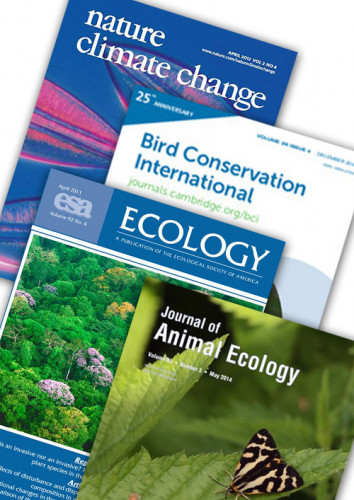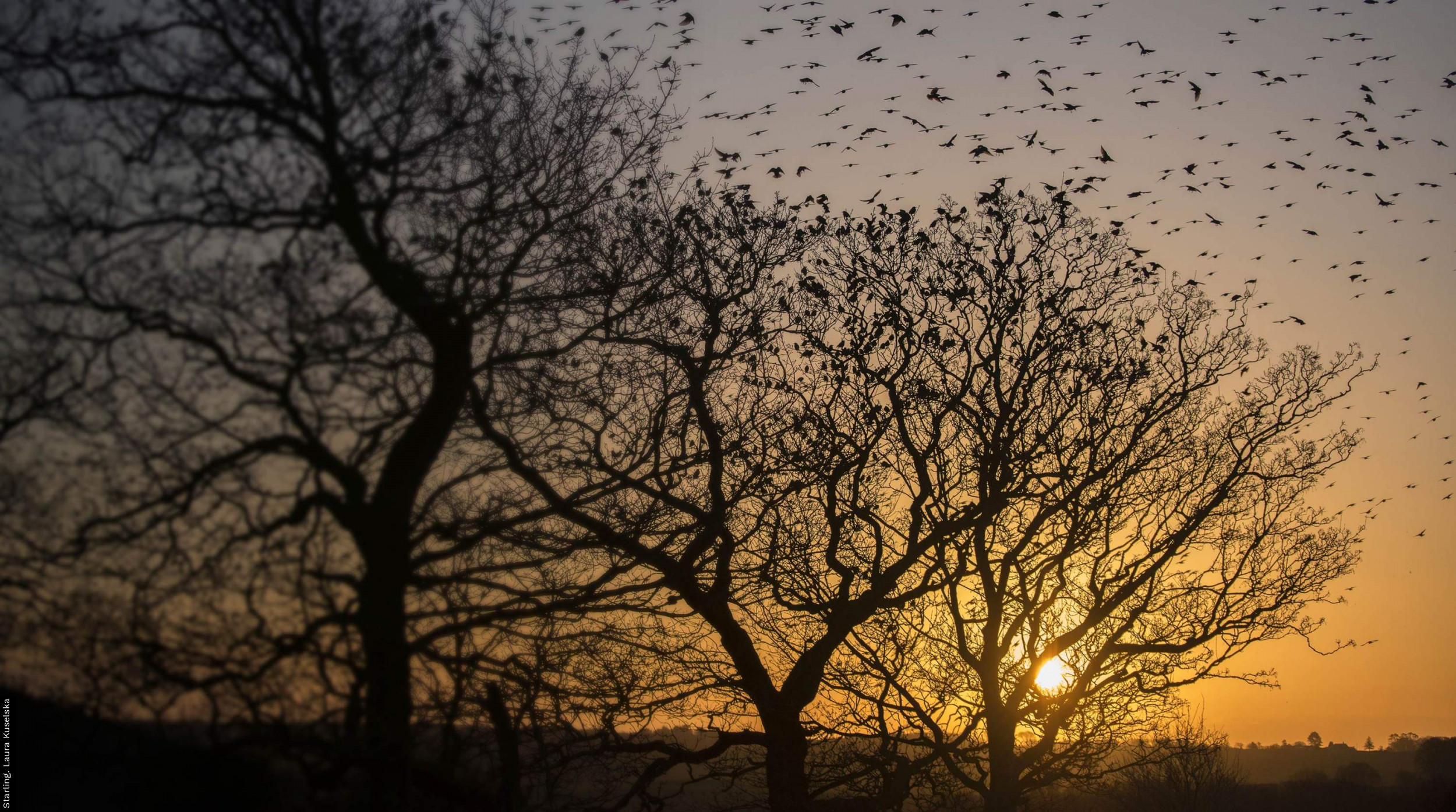Peer-reviewed papers

It is BTO’s policy to make public the results of our research. Our aim is to publish as much as possible of our work in the peer reviewed scientific literature. Many results are also published in our BTO Research Report series.
2022.
A global biological conservation horizon scan of issues for 2023.
Trends in Ecology & Evolution
38
: 96-107
Link to Article (DOI: 10.1016/j.tree.2022.10.005)
2022.
Framework for assessing and mitigating the impacts of offshore wind energy development on marine birds.
Biological Conservation
276
Link to Article (DOI: 10.1016/j.biocon.2022.109795)
2022.
Evidence that rural wintering populations supplement suburban breeding populations.
Bird Study
View Abstract
Link to Article (DOI: 10.1080/00063657.2022.2139814)
2022.
Individual, sexual and temporal variation in the winter home range sizes of GPS-tagged Eurasian Curlew Numenius arquata.
Bird Study
Link to Article (DOI: 10.1080/00063657.2022.2144129)
2022.
Standardised empirical dispersal kernels emphasise the pervasiveness of long-distance dispersal in European birds.
Journal of Animal Ecology
Link to Article (DOI: 10.1111/1365-2656.13838 )
2022.
Loop-migration and non-breeding locations of British breeding Wood Warbler Phylloscopus sibilatrix.
Bird Study
69
: 1-11
Link to Article (DOI: 10.1080/00063657.2022.2138825)
2022.
Diversity, fragmentation and connectivity in the UK amphibian and reptile data landscape.
Biodiversity & Conservation
View Abstract
Link to Article (DOI: 10.1007/s10531-022-02502-w)
2022.
The incursion of Highly Pathogenic Avian Influenza (HPAI) into North Atlantic seabird populations: an interim report from the 15th International Seabird Group conference.
Seabird
34
View Abstract
2022.
Demography of Common Swifts Apus apus breeding in the UK associated with local weather but not aphid abundance.
Ibis
Link to Article (DOI: 10.1111/ibi.13156)
2022.
Trade-offs between the natural environment and recreational infrastructure: a case study about peatlands under different management scenarios.
Land Use Policy
View Abstract
Link to Article (DOI: https://doi.org/10.1016/j.landusepol.2022.106401)
2022.
Modelling important areas for breeding waders as a tool to target conservation and minimise conflicts with land use change.
Journal for Nature Conservation
View Abstract
Link to Article (DOI: https://doi.org/10.1016/j.jnc.2022.126267)
2022.
Long-term trends of second generation anticoagulant rodenticides (SGARs) show widespread contamination of a bird-eating predator, the Eurasian Sparrowhawk (Accipiter nisus) in Britain.
Environmental Pollution
314
Link to Article (DOI: 10.1016/j.envpol.2022.120269)
2022.
Connectivity between countries established by landbirds and raptors migrating along the African-Eurasian flyway.
Conservation Biology
Link to Article (DOI: 10.1111/cobi.14002)
2022.
Habitat-use influences severe disease-mediated population declines in two of the most common garden bird species in Great Britain.
Scientific Reports
12
Link to Article (DOI: 10.1038/s41598-022-18880-8)
2022.
Behavioural responses of non-breeding waterbirds to marine traffic in the near-shore environment.
Bird Study
Link to Article (DOI: 10.1080/00063657.2022.2113855)
2022.
Breeding bird population trends during 2013–2019 inside and outside of European Badger control areas in England.
Journal of Zoology
View Abstract
Link to Article (DOI: 10.1111/jzo.13010)
2022.
Differential changes in life cycle-event phenology provide a window into regional population declines.
Biology Letters
Link to Article (DOI: 10.1098/rsbl.2022.0186)
2022.
The effects of a decade of agri-environment intervention in a lowland farm landscape on population trends of birds and butterflies.
Journal of Applied Ecology
Link to Article (DOI: 10.1111/1365-2664.14246)
2022.
Mismatches in scale between highly mobile marine megafauna and marine protected areas.
Frontiers in Marine Science
Link to Article (DOI: /10.3389/fmars.2022.897104)
2022.
Loss of breeding waders from key lowland grassland sites in Northern Ireland.
Irish Birds
44
: 11-22
2022.
Transatlantic spread of highly pathogenic avian influenza H5N1 by wild birds from Europe to North America in 2021.
Scientific Reports
12
View Abstract
Link to Article (DOI: /10.1038/s41598-022-13447-z)
2022.
Urban and coastal breeding lesser black-backed gulls (Larus fuscus) segregate by foraging habitat.
Ibis
Link to Article (DOI: doi.org/10.1111/ibi.13109)
2022.
Breeding ground temperature rises, more than habitat change, are associated with spatially variable population trends in two species of migratory bird.
Ibis
Link to Article (DOI: 10.1111/ibi.13101)
2022.
Relative roles of static and dynamic abiotic conditions as drivers of foraging behaviour in breeding Sandwich Terns.
Marine Ecology Press
692
: 137-150
Link to Article (DOI: 10.3354/meps14076)
2022.
A 30,000-km journey by Apus apus pekinensis tracks arid lands between northern China and south-western Africa.
Movement Ecology
10
Link to Article (DOI: 10.1186/s40462-022-00329-2)
2022.
Timing is critical: consequences of asynchronous migration for the performance and destination of a long-distance migrant.
Movement Ecology
10
Link to Article (DOI: /10.1186/s40462-022-00328-3)
2022.
Combining host and vector data informs emergence and potential impact of an Usutu virus outbreak in UK wild birds.
Scientific Reports
12
View Abstract
Link to Article (DOI: /10.1038/s41598-022-13258-2)
2022.
Introducing a common taxonomy to support learning from failure in conservation.
Conservation Biology
37
Link to Article (DOI: 10.1111/cobi.13967)
2022.
Bioclimatic context of species' populations determines community stability.
Global Ecology and Biogeography
View Abstract
Link to Article (DOI: https://doi.org/10.1111/geb.13527)
2022.
Recommendations to enhance breeding bird diversity in managed plantation forests determined using LiDAR.
Ecological Applications
Link to Article (DOI: 10.1002/eap.2678)
2022.
Estimating the carbon footprint of citizen science biodiversity monitoring.
People & Nature
Link to Article (DOI: 10.1002/pan3.10333)
2022.
Impact of woodland agri-environment management on woodland structure and target bird species.
Journal of Environmental Management
316
Link to Article (DOI: /10.1016/j.jenvman.2022.115221)
2022.
Assessing drivers of winter abundance change in Eurasian Curlews Numenius arquata in England and Wales.
Bird Study
Link to Article (DOI: 10.1080/00063657.2022.2049205)
2022.
The potential for analyses of monitoring scheme data to inform about the impacts of invasive on native species.
Biological Invasions
Link to Article (DOI: 10.1007/s10530-022-02785-8)
2022.
Hotspots in the grid: avian sensitivity and vulnerability to collision risk from energy infrastructure interactions in Europe and north Africa.
Journal of Applied Ecology
Link to Article (DOI: 10.1111/1365-2664.14160)
2022.
Conservation interventions can benefit species impacted by climate change.
Biological Conservation
269
Link to Article (DOI: 10.1016/j.biocon.2022.109524)
2022.
Demographic variation in space and time: implications for conservation targeting.
Royal Society Open Science
9 (part 3)
Link to Article (DOI: 10.1098/rsos.211671)
2022.
Can citizen science provide a solution for bat-friendly planning?.
Landscape & Urban Planning
223
Link to Article (DOI: 10.1016/j.landurbplan.2022.104402)
2022.
Investigating avoidance and attraction responses in Lesser Black-backed Gulls Larus fuscus to offshore wind farms.
Marine Ecology Progress Series
686
Link to Article (DOI: 10.3354/meps13964)
2022.
Rush or relax: migration tactics of a nocturnal insectivore in response to ecological barriers.
Scientific Reports
12 (part 4 964)
Link to Article (DOI: 10.1038/s41598-022-09106-y)
2022.
Habitat selection and specialisation of Herring Gulls during the non-breeding season.
Frontiers in Marine Science
9
Link to Article (DOI: 10.3389/fmars.2022.816881)
2022.
Linking climate change vulnerability research and evidence on conservation action effectiveness to safeguard European seabird populations.
Journal of Applied Ecology
Link to Article (DOI: 10.1111/1365-2664.14133)
2022.
A framework for climate change adaptation indicators for the natural environment.
Ecological Indicators
136
Link to Article (DOI: 10.1016/j.ecolind.2022.108690)
2022.
Warming temperatures drive at least half of the magnitude of long-term trait changes in European birds.
Proceedings of the National Academy of Sciences of the USA
119
Link to Article (DOI: 10.1073/pnas.2105416119)
2022.
Extreme uncertainty and unquantifiable bias do not inform population sizes.
Proceedings of the National Academy of Sciences of the USA
119
Link to Article (DOI: 10.1073/pnas.2113862119)
2022.
Impacts of COVID-19 restrictions on capacity to monitor bird populations: a case study using the UK Breeding Bird Survey.
Bird Study
Link to Article (DOI: 10.1080/00063657.2021.2019187)
2022.
An assessment of relative habitat use as a metric for species’ habitat association and degree of specialization.
Ecological Indicators
135
Link to Article (DOI: 10.1016/j.ecolind.2021.108521)
2022.
Large-scale citizen science survey of a common nocturnal raptor: urbanization and weather conditions influence the occupancy and detectability of the Tawny Owl Strix aluco.
Bird Study
View Abstract
Link to Article (DOI: /10.1080/00063657.2021.2019188)
2022.
The future distribution of wetland birds breeding in Europe validated against observed changes in distribution.
Environmental Research Letters
Link to Article (DOI: 10.1088/1748-9326/ac4ebe)
2022.
<p>Long-term Effects of Rewilding on Species Composition: 22-years of Raptor Monitoring in the Chernobyl Exclusion Zone </p>.
Link to Article (DOI: 10.1111/rec.13633)



Share this page